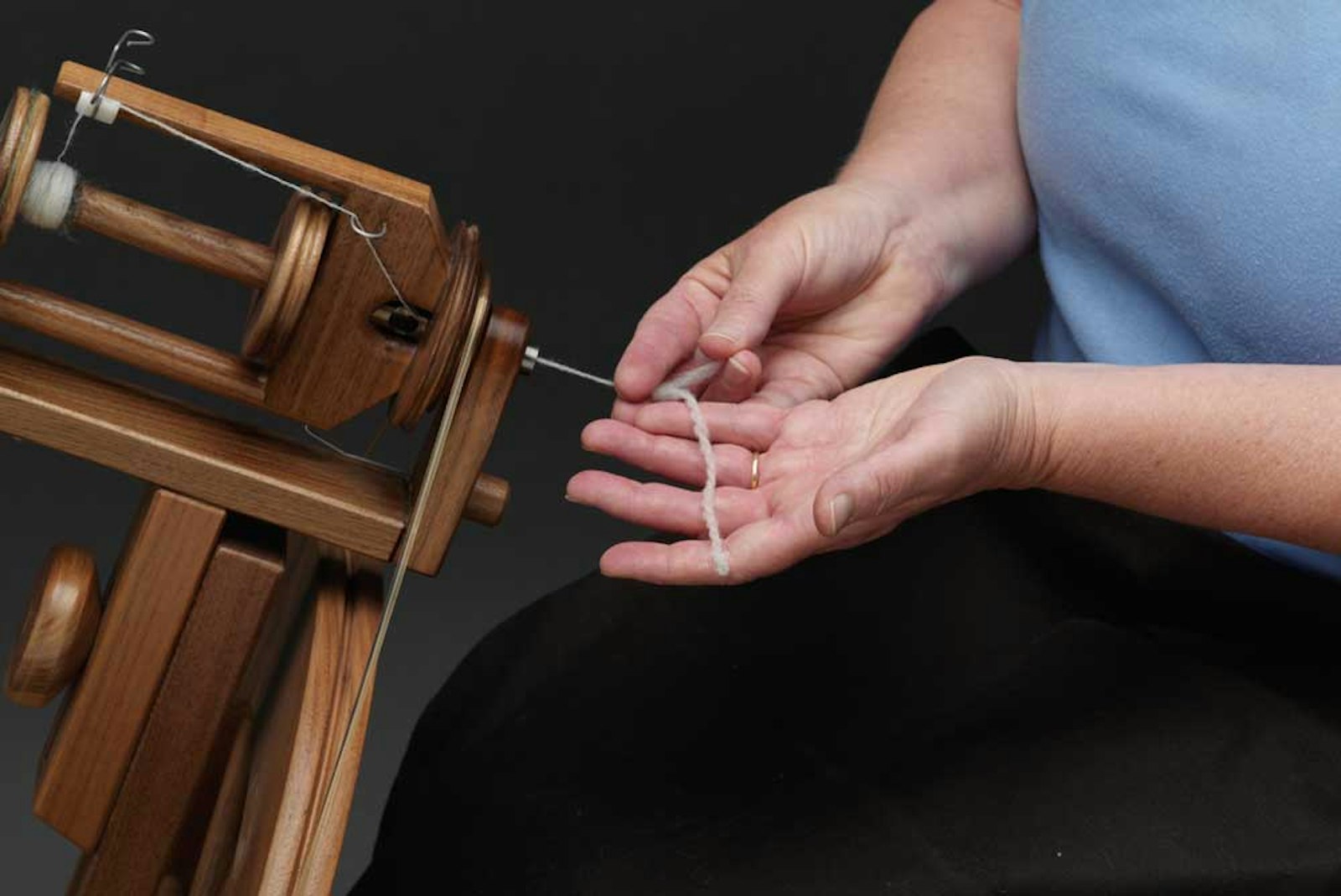Woolen spinning makes a lofty, insulating yarn, with long and short fibers intersecting randomly to create air pockets. Think light and airy throughout the process of making a woolen yarn. Choose an open, clean fleece, with locks three inches or shorter, and scour it well. A woolen yarn is easiest to spin from a wellcarded rolag with a core of air surrounded by fiber. Card rolags in proportion to the desired yarn size. Make small diameter rolags for fine yarn and large diameter ones for fatter yarn. Adjust the wheel by loosening the tension until the flyer parts rotate but there is little pull-in tension. Oil the wheel well and keep the tension light by trying a lighter weight drive band and/or single drive. Work slowly until you feel comfortable with the drafting process. You can always add more twist if necessary, but remember that a woolen yarn should be light.
For an even yarn, use consistently sized rolags, pinch off the same amount for each segment of drafting, and draft back the same distance. For a big yarn, draft back only a very short distance; for a thin yarn, draft the segment back further. If you find yourself twisting your body more than 30 degrees, draft shorter segments of the rolag.
Easing Body Movements During Spinning

Suggestions from Elizabeth Henshaw, BA Movement Studies
Use a chair in which you can sit with your back slightly forward. A pillow at the back of the chair will keep you comfortably in position. If your chair slopes backward, place a cushion or towel on the seat so that you are positioned on top of your sitting bones and have your knees slightly lower than the sitting bones. Work with the wheel close to you to maintain a base of support.
Keep your movements fluid as you spin. Imagine a balloon floating up from your hip, through the rib cage and into the shoulder and then the arm of the hand holding the fiber. Use the energy coming up through your body as you turn to draft. Float the arm out so that it is supported by the breathing in your lungs as you extend to draft. Avoid the stress caused by overextending the arm backward or twisting the body more than about 30 degrees. Also, over-extending your body may mean that you keep adding fibers into the drafting zone instead of only drafting a segment of rolag. A small towel under the sitting bone on the side with your passive hand helps to give lift as you breathe into the drafting movements.

1) Start by attaching the rolag to the leader thread and drawing out a few inches while adding twist to secure the join.

2) The passive hand stays 4" to 5" away from the orifice. Its job is to pinch the twist off and on as needed. It should stay in the same place except to pull off a bit of fluff or vegetable matter or to catch a broken yarn. It does not smooth the yarn or move back to meet the active hand.

3) The active hand holds the fiber. It starts 7" to 8" away from the passive hand and does not get closer. There should always be twisted yarn between the passive hand and the orifice and between the passive and active hands.

4) Begin by pinching off a section of rolag (1" to 1 1⁄2") with the thumb and forefinger of the active hand. While treadling the wheel, pull the pinched-off section of the rolag back against the twist until it is the desired diameter. Think of the section of rolag elongating and holding that core of air. Do not let more fiber from behind the pinched-off section in the active hand enter the drafting zone.

5) While you’re drafting back with the active hand, open and close the thumb and forefinger of the passive hand to let in or pinch off twist as necessary. Usually there is enough twist built up in the yarn between the active and passive hands to draft out the unspun fibers without adding more twist. There should be just enough twist to hold the unspun fibers together but not so much that you can’t draft out any uneven spots.

6) When the yarn is drafted to the desired diameter, add enough twist to hold it together.2 Move the active hand toward the orifice but only back to the starting position—7" to 8" away from the passive hand. If the yarn doesn’t feed onto the bobbin easily, add a bit more tension until it does so.

7) Go to the next section of the rolag by opening the forefinger and thumb of the active hand and floating them over the rolag 1" to 1 1⁄2" backward and then closing the fingers to pinch off that section. Repeat Steps 4–7 until a rolag is almost spun up; overlap the last bit with a new rolag and continue.
8) The result is a beautiful soft and lofty yarn!
Carol Rhoades spins her light and airy knitting yarns in Austin, Texas.
Download a PDF reference of Carol's longdraw lesson:
Originally published in the Winter 2004 issue of Spin Off magazine.

